Lissa Johnston's Blog, page 21
April 28, 2016
Your Mark: The History of Monogrammy
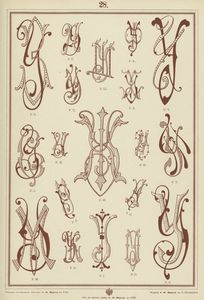 Cyrillic monogrammy of the letter Y
Cyrillic monogrammy of the letter Ycirca 1902Branding is all the rage now. Business owners from solopreneurs to megacorporations are encouraged to come up with a visual symbol to represent ourselves to the world.
The concept of branding may seem like a recent development, but it's hardly new. Literal branding of livestock (as well as human property, unfortunately) has been practiced for thousands of years. It was a simple and effective way of denoting ownership and discouraging theft. (Best not to ask how the brandee felt about it.) The subset of branding known as monogramming, or combining letters to form a new symbol, also is nothing new. Ancient coins were marked in this way to denote place of origin. Artists also found it a handy shorthand in signing their work.
 The monogram became associated with the upper classes because long ago, the upper classes were the only ones who had any property worth protecting! Gradually the trend filtered down through the various layers of nobility. By Victorian times, monogramming was all the rage among the non-royal wealthy. As sewing skills were widespread among the middle and lower classes prior to the industrial age, monogramming became an inexpensive way to add a touch of class.
The monogram became associated with the upper classes because long ago, the upper classes were the only ones who had any property worth protecting! Gradually the trend filtered down through the various layers of nobility. By Victorian times, monogramming was all the rage among the non-royal wealthy. As sewing skills were widespread among the middle and lower classes prior to the industrial age, monogramming became an inexpensive way to add a touch of class.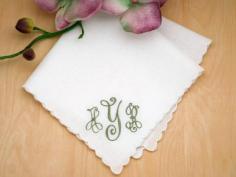 Technically, it's not a monogram
Technically, it's not a monogram unless there's more than one
letter represented.
 Tennis legend Roger Federer
Tennis legend Roger Federeris the master of his brand
as well as the courtThese days monograms are everywhere, from the fingertip towels in Aunt Hattie's guest bath to the toned torsos of sports superstars. Maybe it's time for you to get on the branding train. If you're stumped for a brand logo, get back to the basics and use your initials. Just pick a cool font, avoid embarrassing letter combinations, and let those letters represent.
This post represents my participation in the 2016 A to Z Blog Challenge. We're working our way through the alphabet with posts relating to a different letter most days throughout April. Would love to hear from you in the comments section below. Thanks for dropping by!
Published on April 28, 2016 09:23
April 27, 2016
Female Executions: XX marks the spot
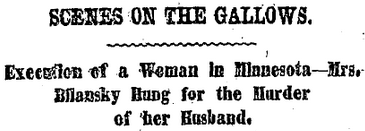 While browsing the news one day when we still lived in Minnesota, I read about a woman called Ann Bilansky. Ann has the dubious distinction of being the first white person and first (and last) woman executed after Minnesota became a state. She was hanged in 1860 after being convicted of the poisoning death of her husband.
While browsing the news one day when we still lived in Minnesota, I read about a woman called Ann Bilansky. Ann has the dubious distinction of being the first white person and first (and last) woman executed after Minnesota became a state. She was hanged in 1860 after being convicted of the poisoning death of her husband.This news nugget made me wonder about other women who have been executed for their crimes. There aren't that many, thank goodness! But there are more than fifty that have met that fate from colonial days to the present. A small percentage compared to five figures' worth of men executed, but still, fifty is a lot.
Of these, half a dozen were considered serial killers; most in the modern era. Several were killed during the Salem Witch Trial era. A disturbing number were convicted of murder by poison, usually arsenic. I suppose it's true what they say: poison is a woman's weapon.
Fellow writers, if you're looking for story ideas, look no further. There are some real doozies. And as they say, truth is stranger than fiction.
Some notorious female criminals are familiar to many of us.
The movie Monster starring Charlize Theron was based on the life of serial killer Ailene Wuornos, who was executed by lethal injection in 2002. Ethel Rosenburg and her husband Julius got the chair in 1953 after being convicted of espionage (selling nuclear secrets to the Russians).Mary Surratt was hung in 1865 for her role in the conspiracy to assassinate Abraham Lincoln.
And then there are the less well-known. As you can imagine, there are some fascinating stories lurking in the background. Consider:
 Martha Beck, who got the chair at Sing Sing in 1951. She was one half of the infamous Lonely Hearts Killers duo. Trust me, folks, this is one of the rare occasions I did NOT enjoy the research process. Lawd. I think the entire series of Law & Order SVU is some iteration of their sordid tale.Elizabeth Van Valkenburgh was executed in 1846 for poisoning her husband. She was hanged while sitting in her rocking chair, as she was tremendously overweight and the executioners wanted to avoid botching it.Two unfortunates who did not avoid botching: Roxana Druse, whose botched hanging in 1887 resulted in a slow, agonizing death by strangulation; and Eva Dugan, who was decapitated during her hanging in 1930. Both fiascos resulted in a change in methods of execution in the respective states (Arizona and New York). Josefa "Chipita" Rodriguez was hanged in Texas in 1863. She said little during her trial for murder during the commission of a robbery. It's thought she was covering for her son. Her last words were something to the effect of 'I'm not guilty'. Rumors abound that moans were reported coming from her coffin. Her ghost is said to haunt the town of San Patricio, where she died.Hannah Ocuish is the youngest known legally executed person in American history. She was 12 when hanged in 1786; her victim was 6. Hanna beat her friend to death for ratting on her over some stolen strawberries.Lavinia Fisher was hanged in 1820, convicted of crimes perpetrated on guests at an inn she and her husband owned in Charleston, South Carolina. There are some wild rumors about their exploits. My favorite is that like one of the female villains in the James Bond lexicon, Lavinia killed by crushing her victims' heads between her legs.
Martha Beck, who got the chair at Sing Sing in 1951. She was one half of the infamous Lonely Hearts Killers duo. Trust me, folks, this is one of the rare occasions I did NOT enjoy the research process. Lawd. I think the entire series of Law & Order SVU is some iteration of their sordid tale.Elizabeth Van Valkenburgh was executed in 1846 for poisoning her husband. She was hanged while sitting in her rocking chair, as she was tremendously overweight and the executioners wanted to avoid botching it.Two unfortunates who did not avoid botching: Roxana Druse, whose botched hanging in 1887 resulted in a slow, agonizing death by strangulation; and Eva Dugan, who was decapitated during her hanging in 1930. Both fiascos resulted in a change in methods of execution in the respective states (Arizona and New York). Josefa "Chipita" Rodriguez was hanged in Texas in 1863. She said little during her trial for murder during the commission of a robbery. It's thought she was covering for her son. Her last words were something to the effect of 'I'm not guilty'. Rumors abound that moans were reported coming from her coffin. Her ghost is said to haunt the town of San Patricio, where she died.Hannah Ocuish is the youngest known legally executed person in American history. She was 12 when hanged in 1786; her victim was 6. Hanna beat her friend to death for ratting on her over some stolen strawberries.Lavinia Fisher was hanged in 1820, convicted of crimes perpetrated on guests at an inn she and her husband owned in Charleston, South Carolina. There are some wild rumors about their exploits. My favorite is that like one of the female villains in the James Bond lexicon, Lavinia killed by crushing her victims' heads between her legs.
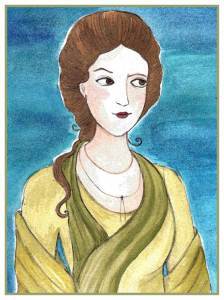 Lavinia Fisher
Lavinia FisherPresently there are fifty or so women sitting on death row somewhere. They may not all face execution. Some may escape, a la The Shawshank Redemption. Some may escape legally by having their convictions overturned. Some may avoid the chair or the needle if the capital punishment laws in their area change. Some may not outlive their sentence. One thing's for sure: that extra X chromosome is not much protection if you do the crime.
This post represents my participation in the 2016 A to Z Blog Challenge. We're working our way through the alphabet with posts relating to a different letter most days throughout April. Would love to hear from you in the comments section below. Thanks for dropping by!
Published on April 27, 2016 12:51
April 26, 2016
The WPA: Working Wonders
 "Chief Tuscumbia Greets the Dickson Family"
"Chief Tuscumbia Greets the Dickson Family"Jack McMillenI'm a sucker for art on a grand scale, like murals on the side of multi-story buildings, and the artist who wraps entire structures in fabric. I don't see many fabric-wrapped structures in my travels, but I do see murals fairly often. And when I do, I always think of the WPA, whether they're responsible or not.
The WPA, known as the Works Progress or Works Projects Administration, was, in my humble opinion, one of the greatest innovations of FDR's New Deal program during the Depression Era. The WPA operated from 1935-1943. It was intended to put at least one household member to work in every household that had no one working. Even better: if the unemployed person had no skills, they learned one as part of this program - no excuses!
 "Themes of the National Parks"
"Themes of the National Parks"David McCoshThe lion's share of the budget for the WPA went for construction projects, like building roads and painting buildings and so forth. But a small sliver of the budget was earmarked for creating art, art in many forms: paintings, books, music, performance. And the beauty of the program was that it sought out artists who were unemployed, so experimental artists such as Jackson Pollock found support and recognition they otherwise may not have gotten.
The WPA program ended when the nation reached its goal of full employment in 1943. By then, millions of people had benefited from WPA programs, including an estimated 10,000 artists. And of course, millions more of us benefit today, enjoying the fruits of their labors.
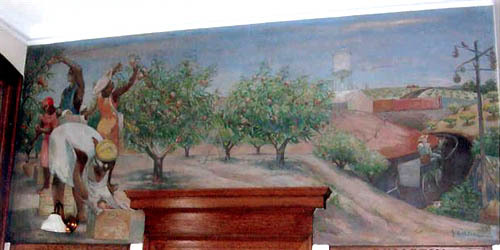 "Peach Orchard"
"Peach Orchard"Irving A. BlockAs I was researching this post, naturally I wondered if there were any extant WPA projects near where I live. Turns out there are tons of public works-type projects in South Carolina - buildings, roads, bridges, etc. But I was delighted to find a New Deal painting exists in a privately owned but vacant building in the town nearest to me (we live out in the boonies). It's called "Peach Orchard" by Irving A. Block. So get to Googling - there might be a WPA beauty on a wall near you :)
Fun Fact: Why peaches, you might wonder? Why not grits, or collards? Turns out South Carolina is the #2 peach producing state in the USA, second only to California. Take that, Georgia! BTW Local peach stands will start selling that golden peachy deliciousness soon, with prime eating mid-June and later. My neighbor, who knows all, says the first harvest is best for preserves and jams and such, so we wait for the second harvest to buy for gobbling them down on the ride home. It's awesome living in peach country.
This post represents my participation in the 2016 A to Z Blog Challenge. We're working our way through the alphabet with posts relating to a different letter most days throughout April. Would love to hear from you in the comments section below. Thanks for dropping by!
Published on April 26, 2016 10:08
April 25, 2016
Vaudeville: A Variety of Vixens and Villains
 Vaudeville soft shoe dance act
Vaudeville soft shoe dance actDoyle and DixonIt's not the first time, nor will it be the last, that I exhort you to visit the New York Public Library's stupendous online digital collection, home of wonder, lore and inspiration for writers (and fellow history nerds!) everywhere. Today we will explore the entertainment style known as Vaudeville, featuring images generously shared with us by the NYPL.
The origin of the word 'Vaudeville' is in dispute. Its roots are most likely French, if that final syllable is any indication. The Vaudeville style consists of a pastiche of several different acts bound into a single session of entertainment. There might be some comedy, some dancing, some acrobatics, maybe an animal act, or some recitation. Vaudeville was specifically geared toward more genteel audiences - no booze served, no cursing, no naughty bits. The bawdier stuff was left to all male venues such as saloons, and burlesque shows.
Fun fact: the custom of referring to off-color behavior such as nudity or cursing as 'blue' originated in the Vaudeville era. The B. F. Keith theater circuit was the Amazon of Vaudeville - they dominated the industry. Mr. Keith had very strict guidelines for the contracted performers. Anyone caught violating said guidelines would likely receive a dreaded blue envelope containing strong suggestions on censoring that part out of their act. If they didn't comply, they were censored - fired, cut, kicked to the curb. The blue envelope was the predecessor of the 20th century pink slip.
Variety acts had been around since jesters learned to play a lute in addition to singing and telling
 Vaudeville era magician
Vaudeville era magicianHoward Thurstonjokes. The Vaudeville style of variety shows began to flourish toward the end of the 1880s when theater manager Tony Pastor got the bright idea to carve out a niche for himself. He decided to literally clean up the acts, offering family-friendly entertainment in his shows. It was a huge hit. Two enterprising businessmen took things to the next level when they came up with the idea of forming a chain of theaters and contracting with performers to present the same show at various theaters in the chain. This innovation helped performers by giving them a longer contractual period (weeks or months rather than one night stands) and thus more stability. It also benefited the venue managers by simplifying the booking process and likely reduced their cost per act when hiring for multiple dates.
Vaudeville began to wane in the early 1900s when radio, television, and movie technology emerged. Audiences loved the new forms of entertainment and couldn't get enough of it. Gradually the grand old vaudeville theaters installed screens and projectors and live acts took a back seat. The last Vaudeville acts closed their doors in the 1940s. But the concept of offering variety persisted into the movie era. Just ask anyone who was a kid in the 1940s what they got to see for a nickel at the Saturday matinee. It was probably a couple of cartoons, a news reel, and a main feature.
 Two of the experimental dance group
Two of the experimental dance groupThree Little MaidsMany entertainers in the 1930s and 1940s got their start in Vaudeville. Judy Garland, Harry Houdini, Will Rogers, and The Three Stooges come to mind. Some famously did not make the transition, immortalized by the Nora Desmond character in the movie Sunset Boulevard . Remnants the of Vaudeville format remain in more modern entertainment classics such as The Carol Burnett Show and, more recently, late night talk shows, which often intersperse multiple guests of various talents with musical interludes. Like Nora Desmond, Vaudeville may have been left in the dust. But variety is still very much the spice of entertainment life.
This post represents my participation in the 2016 A to Z Blog Challenge. We're working our way through the alphabet with posts relating to a different letter most days throughout April. Would love to hear from you in the comments section below. Thanks for dropping by!
Published on April 25, 2016 09:59
April 23, 2016
Unbound: A Brief History of Undergarments
 Legend says she constructed the prototype
Legend says she constructed the prototypefrom two hankies and some ribbonI've had an idea for this post sitting around in my drafts folder ever since I learned that bras were originally designed to reduce the silhouette of the bosom, not enhance them. During the Roaring Twenties, the Flapper look was all the rage. It was as far from the previous style as one could get, from neckline to hemline. It dispensed with corsets altogether, thank goodness! But as most of us ladies know through sad experience in the 1960s, the majority of the female population benefits from a little support up there, whether it is pushing up, pushing out, or pressing flat. Enter one Mary Phelps Jacob, a plucky New Yorker who invented the modern brassiere out of frustration with corsets.
Some interesting tidbits (yeah, yeah, insert bosom wordplay if you must):
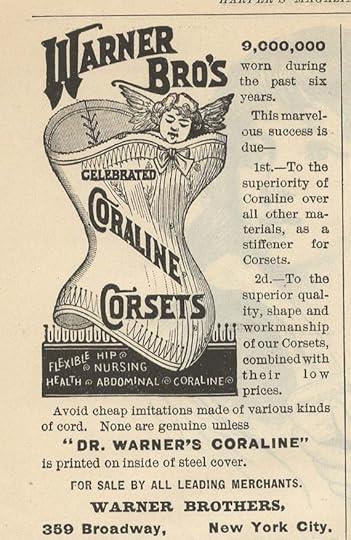 Ms. Phelps used a nom de bra and marketed her new invention as 'Caresse Crosby'. That's a name made for a romance novel if I ever heard one.She sold her idea to Warner Brothers Corset Company. Warner's Bras is still in business. They do not have any apparent connection to the movie studio of the similar name. However, they are the inventors of the alphabet cup sizing method still in use today.
Ms. Phelps used a nom de bra and marketed her new invention as 'Caresse Crosby'. That's a name made for a romance novel if I ever heard one.She sold her idea to Warner Brothers Corset Company. Warner's Bras is still in business. They do not have any apparent connection to the movie studio of the similar name. However, they are the inventors of the alphabet cup sizing method still in use today.As for the nether regions, modern undies also came on the scene in the first half of the twentieth century. Prior to that, there was a time when nothing was worn under all those heavy long skirts. Fresh air was considered good for the privates. In the 1800s, a light garment known as pantaloons added an extra layer, especially welcome in chilly climates. Initially they covered only the legs and were open nearer the top (some might say crotchless), for ease in answering the call of nature. Eventually they came to look more like a loose set of capri pants. As dresses shortened and became more form fitting, unmentionables needed to evolve as well. More items of interest:
 Flappin' in the breeze Some think the modern ladies' brief is based on the design of a baby's diaper. Now that you mention it . . .
Flappin' in the breeze Some think the modern ladies' brief is based on the design of a baby's diaper. Now that you mention it . . .Wearing form-fitting undies daily is a relatively recent (20th century) development. Prior to that time, they were only worn during a certain time of the month to keep feminine hygiene products in place.
And with that, we'll stop and save that whole discussion for another blog post. You gents reading this can exhale now.
Published on April 23, 2016 18:18
April 22, 2016
Teetotaler, or Just Temperate?
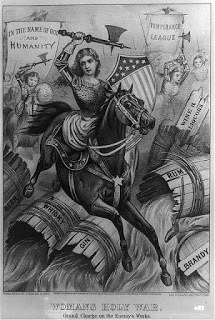 Temperance as 'holy war'
Temperance as 'holy war'Currier & Ives lithograph 1874
Library of CongressWhile I was researching my latest book, The Dala Horse , I read in Charles H. Russell's wonderful biography of Elise Waerenskjold that she and her husband had attempted to form a temperance society after they immigrated to Texas from Norway. They came to Texas in 1847. By 1855 they determined some temperance was in order.
Their guidelines were a little softer than the zero tolerance policies embraced later. Apparently some of the 'Texwegians' enjoyed a nip of brandy a little too often. And who could blame them - life was tough out there on the prairie! Elise's proposed temperance society aimed to eliminate drinking to excess, rather than eliminating drinking altogether. Beer and wine consumption was considered so harmless, it wasn't even included in their plans. But there was a disagreement how to handle hard liquor, or 'spirits'. Some felt it should not be allowed at all. It became clear this stance was a deal-killer, so in the interest of compromise, all agreed some hard liquor could be imbibed, as long as not to excess.
When I think of temperance, I envision early 20th century women in long skirts and big hats hoisting homemade placquards as they march on their local Main Street. Turns out I was only off by about a hundred years. By the 1830s it was already a thing, with movements documented in America, England, Australia, and New Zealand. There were societies, and songs, and pledges, and everything! Early temperance groups rarely pushed for government regulation of alcohol. Rather, they encouraged individuals to take personal responsibility. The Sunday pulpit and the local newspaper were the main vehicles of imparting this message.
Initial temperance movements focused on exactly that: tempering one's habits. Inevitably a splinter group formed, pushing to completely ban consumption. This view was labeled 'teetotalism'. Growing up in the south, I often heard non-drinkers described as teetotalers.
Let's digress for a moment and explore the origins of this word. There is a rather unkind anecdote suggesting it arose from one fellow's unfortunate speech impediment when trying to express that he was t-t-totally against drinking alcohol. Another theory is the repetition of the T in Total - "Tee Total" - adds emphasis to the speaker's strong belief in the philosophy.
The temperance movement gained momentum until it hit a speed bump in the U.S. during the Civil War. Temperance is all well and good, you see, until we need some taxes to pay for our war. Then we need to let the alcohol flow so we can collect the duties on it.
After the Civil War ended, and the need for alcohol duty income waned, the temperance movement resumed and became as powerful as it ever had been - until World War I. Ironically, rather than being seen as a way to generate tax income, alcohol production was now viewed as a frivolous waste of resources.The temperance societies thus got an unexpected boost in the early 20th century when alcohol supplies dwindled.
 Supporters of temperance saw an opportunity. They pressed their advantage. Groups of women thronged outside of bars, shaming the occupants by singing hymns at the top of their voices. They staged the temperance version of sit-ins, but instead of sitting, they poured out or otherwise destroyed enormous quantities of (perfectly good) alcohol. There was even something called the Whiskey War in Ohio. Extreme Teetotaler Carrie Nation was known for busting up many a whiskey keg with her fearsome hatchet.
Supporters of temperance saw an opportunity. They pressed their advantage. Groups of women thronged outside of bars, shaming the occupants by singing hymns at the top of their voices. They staged the temperance version of sit-ins, but instead of sitting, they poured out or otherwise destroyed enormous quantities of (perfectly good) alcohol. There was even something called the Whiskey War in Ohio. Extreme Teetotaler Carrie Nation was known for busting up many a whiskey keg with her fearsome hatchet.These stunts had the desired effect. What could be seen as their biggest success to date resulted occurred in the U.S. in 1920 with the passage of 18th amendment. This outright ban of alcohol sales at the federal level became known as the Prohibition Era. Other countries such as Australia, New Zealand, Norway, Finland, and Iceland also experimented with varying degrees of prohibition, such as reducing the alcohol content of some beverages, and mandating earlier closing times for bars.
Alas, it was not meant to last. People got downright cranky about not having any booze. The temperance movement fell out of favor. Citing rising crime rates related to black market (think Untouchables which btw is a pretty good movie if you haven't seen it), as well as a negative effect on the economy (again with the taxes or lack thereof), Prohibition ended in 1933. This was not the end of temperance; just the end of it being supported via national law.
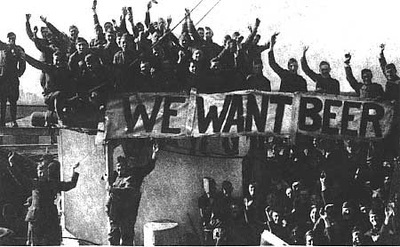 And so the pendulum swings the other wayDespite its disappointing defeat with the repeal of Prohibition, temperance has rocked on in some sectors. Many religions have a long history of banning alcohol, without any help from the federal government. Muslims and Mormons come to mind. Growing up as a Southern Baptist, I can report that we were expected to abstain (other religions used real wine during their communions; Baptists used grape juice). In the American South, abstention was often the rule rather than the exception. Areas of my hometown of Dallas, Texas, were 'dry', meaning no alcohol was sold there. And many counties throughout the state were dry as well. But economics will out: many of these formerly dry areas have become wet over the last twenty years or so. And when these areas become 'wet', their economies really boom.
And so the pendulum swings the other wayDespite its disappointing defeat with the repeal of Prohibition, temperance has rocked on in some sectors. Many religions have a long history of banning alcohol, without any help from the federal government. Muslims and Mormons come to mind. Growing up as a Southern Baptist, I can report that we were expected to abstain (other religions used real wine during their communions; Baptists used grape juice). In the American South, abstention was often the rule rather than the exception. Areas of my hometown of Dallas, Texas, were 'dry', meaning no alcohol was sold there. And many counties throughout the state were dry as well. But economics will out: many of these formerly dry areas have become wet over the last twenty years or so. And when these areas become 'wet', their economies really boom. In hindsight, it appears the heavy hand of government intervention that resulted in the Prohibition era was perhaps not the best solution for encouraging temperance. The early adopters had the right of it: let each of us govern ourselves. Enjoy responsibly.
This post represents my participation in the 2016 A to Z Blog Challenge. We're working our way through the alphabet with posts relating to a different letter most days throughout April. Would love to hear from you in the comments section below. Thanks for dropping by!
Published on April 22, 2016 07:38
April 21, 2016
Southern Expressions: The South In Your Mouth
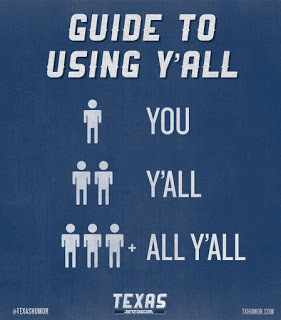 For today's topic, I'm indulging myself and picking some low-hanging fruit. I was born and raised in Texas. You might find some argument about whether Texas is South or West or some combination. But when it comes to southern expressions, Texas definitely qualifies as South.
For today's topic, I'm indulging myself and picking some low-hanging fruit. I was born and raised in Texas. You might find some argument about whether Texas is South or West or some combination. But when it comes to southern expressions, Texas definitely qualifies as South.I grew up listening to many of these expressions issue forth from friends and relatives. I thought nothing of it, until I once politely refused a second helping at a non-Southern soiree because I was 'full as a tick'. Jaws dropped. Eyes bulged. It was at that moment I realized I was, in fact, bilingual.
The great thing about learning to speak and understand southern expressions is that you don't have to learn a new language. You just have to rearrange some words from the language you already know.
Some southern expressions have gained widespread familiarity, like y'all (all of you, or maybe just you) and fixin' to (about to) and bless your heart (you're a moron). But there are many, many others. Most require some translation. Here are a few of my favorites.
Let's do the dogs first:
that dog won't hunt - whatever you just proposed or suggested has fatal flaws in its logic
I've got no dog in that fight - I really don't care what the outcome is
don't get the big dog off the porch - leave well enough alone; sometimes rephrased in other parts of the country as 'don't poke the bear'
Okay, done with the dogs.
all hat no cattle - full of bluster; someone who is too full of him or her self for no apparent reason
I don't know whether I'm washin' or hangin' - one of my mom's phrases to indicate she's crazy busy
colder than a witch's tit in a brass bra - one of my dad's jewels. Sometimes you hear the first part by itself, but Dad being Dad, he always likes to add the bit about the bra.
Speaking of cold -
butter wouldn't melt in her mouth - she is a cold person; shorthand for bi***
nervous as a long-tailed cat in a rocking chair factory or a one legged man at a butt kickin' contest
not my first rodeo - both my husband and I are overly fond of this one. It just means you've done whatever it is you're doing before. Often used in a snippy tone in response to someone who may express doubts at your ability to perform the task at hand.
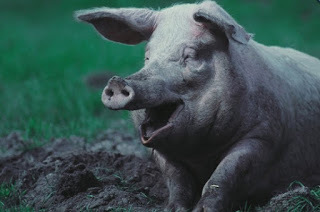 fish or cut bait - make up your mind; occasionally more crudely expressed as sh** or get off the pot
fish or cut bait - make up your mind; occasionally more crudely expressed as sh** or get off the pothappy as a pig in sh** - believe it or not, I've probably heard this said about newlyweds more than I care to remember. Some people substitute 'mud' in polite society, but sh** is what they really mean.
It says something about southern culture that there are so many expressions for someone who is
not the brightest bulb
not the sharpest knife in the drawer
ain't got the sense God gave a goose
doesn't know enough to come in out of the rain
dumb as a carrot
In addition to the 'full as a tick' fiasco, I probably get the second highest number of quizzical looks when I use a Southernism to describe something that is diagonally across from something (kitty corner) or in disarray (cattywompus).
When I was a teenager, my dad sometimes said I would argue with a fence post. I thought it was a compliment.
If you're traveling with a Southerner and they say their back teeth are floating, you best pull over at first opportunity so they can use the facilities.
If my brother and I happen to be out and about and observe the person walking ahead of us who is, shall we say, overly endowed in the posterior, my brother will inevitably whisper to me that her rear end looks like two beavers fightin' under a bear rug. And inevitably I will laugh my head off.
If you're like me and trying to embrace the new minimalist fad and get rid of too much stuff, here's a mantra that might help the next time you are tempted to buy more stuff: I need that like a hen needs a flag.
that and a nickel will get you a cup of coffee - whatever this refers to is worth zero zip nada
 Photo by Ruth Hartnup on Flickrknee high to a grasshopper - Southerners hear this phrase about eight thousand times from older relatives when attending a family reunion or any time they haven't seen you since you were a kid.
Photo by Ruth Hartnup on Flickrknee high to a grasshopper - Southerners hear this phrase about eight thousand times from older relatives when attending a family reunion or any time they haven't seen you since you were a kid.My strategy when learning a new language is to pick one or two phrases that might fit in with your lifestyle and try them out, gingerly at first, until you get the hang of it. Maybe tell your loved one their new outfit is fine as frog's hair. Or tell your kids to quit playin' possum and get up before they're late to school. And if I might offer a suggestion: when dining out with non-Southern friends, don't mention ticks at the dinner table.
This post represents my participation in the 2016 A to Z Blog Challenge. We're working our way through the alphabet with posts relating to a different letter most days throughout April. Would love to hear from you in the comments section below. Thanks for dropping by!
Published on April 21, 2016 16:00
Rodeo Clowns and Raging Bulls
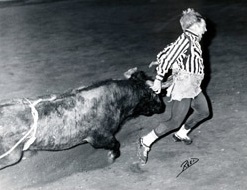 Over the winter we were at a sports bar having lunch. It was one of those places that has a bazillion televisions, all tuned to a different sporting event. I happened to be facing one that had bull riding on. I couldn't look away! It was fascinating. And I was fascinated by my level of fascination. Mainly for the bulls. They were real, and they were magnificent.
Over the winter we were at a sports bar having lunch. It was one of those places that has a bazillion televisions, all tuned to a different sporting event. I happened to be facing one that had bull riding on. I couldn't look away! It was fascinating. And I was fascinated by my level of fascination. Mainly for the bulls. They were real, and they were magnificent.While absorbing this new experience, I noticed the poor souls responsible for making sure the bull rider doesn't get the phooey stomped out of him if he is thrown or when he exits the bull after his 8 seconds (which btw is about 7 seconds too long). They weren't dressed up as one might expect from the term 'rodeo clowns', so I did some digging.
 Wait - aren't they supposed to be INSIDE the barrel?
Wait - aren't they supposed to be INSIDE the barrel?Click here for a great article on the perils
of rodeo clowningTurns out they are called 'bullfighters' which of course brings a very different mental image to me. But they are indeed offshoots of the original rodeo clown, which debuted in the early 1900s. When they began, rodeo clowns were designed to entertain the crowd during delays in the rodeo action. Some wore silly costumes and incorporated physical humor into their comedy routines.
The role of distraction and protection emerged after about 1920 when bulls were introduced into rodeo sports. Unlike horses, who usually quit jumping and kicking once the rider makes his exit, the bulls were still a little salty, as my son's girlfriend would say, and kept twisting and snorting with blood in their eye like a bovine Tasmanian Devil. They're especially happy to keep stomping the stuffing out of the guy they just hurled to the ground. Enter the rodeo clown. Their job is to distract, and sometimes offer assistance to the rider to help him out of harm's way.
I wonder how that first conversation went, convincing the local comic to not only run through his rodeo patter, but also get in the ring with a literal raging bull. I assume there was a financial incentive. Turns out many rodeo clowns transitioned from rodeo competition to rodeo clown, because with the latter, they are at least guaranteed a paycheck. In rodeo, if you don't finish in the money, you go home empty handed.
 Even then, he preferred the term 'bullfighter'There are usually two or three clowns on the job simultaneously. One is there to distract; the others are to help the rider. Over the years, they have come up with innovations to protect themselves. Legendary rodeo clown Jasbo Fulkerson (a fellow Native Texan, thank you very much) invented the iconic barrel used as a sort of rodeo clown foxhole. Many wear protective clothing under their clown costumes, padded like an NFL linebacker. And I don't blame them one bit.
Even then, he preferred the term 'bullfighter'There are usually two or three clowns on the job simultaneously. One is there to distract; the others are to help the rider. Over the years, they have come up with innovations to protect themselves. Legendary rodeo clown Jasbo Fulkerson (a fellow Native Texan, thank you very much) invented the iconic barrel used as a sort of rodeo clown foxhole. Many wear protective clothing under their clown costumes, padded like an NFL linebacker. And I don't blame them one bit.It is tradition for the rodeo clowns to wear a specific style of clown makeup. White around the eyes and mouth; red on the nose. That's it, plain and simple. No feather boas or glitter for this crowd. The profession itself is returning to its entertainment roots. Those who clown are often separate from those who protect (the aforementioned bullfighters).
Turns out comedians/actors Chill Wills and Slim Pickens spent some time as rodeo clowns early in their careers. Who knew??
The Professional Rodeo Hall of Fame in Colorado Springs honors rodeo clowns along with other rodeo stars, as well they should. If you're ever clicking around the telly and see some bull riding going on, check it out. Those clowns (and riders!) are all crazy, but I'm just crazy enough to want to watch.
This post represents my participation in the 2016 A to Z Blog Challenge. We're working our way through the alphabet with posts relating to a different letter most days throughout April. Would love to hear from you in the comments section below. Thanks for dropping by!
Published on April 21, 2016 11:00
Quackery For All That Ails You
Here's where all my time wasted spent playing Words With Friends pays off. Stumped for a topic for a troublesome letter like Q and what do I do - gnash my teeth and grub around in the closet for my hair shirt? Nope! I hit up the cheater Scrabble page and find a Q word to riff on. And this one is a dandy.
Scams via infomercials and email are just the latest iteration of snake oil salesmen/women. They have a fine tradition in print media long before the Internet came along. Preying on an unsuspecting and uninformed public is their stock in trade. Take for example:
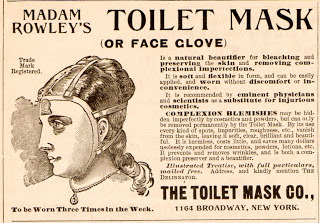
I don't know about you, but I'm totally not wearing anything on my face that has the word 'toilet' in its name.


And where was this little beauty when I was looking for a topic for P??


Know someone who drinks too much booze? Get them addicted to cocaine instead!

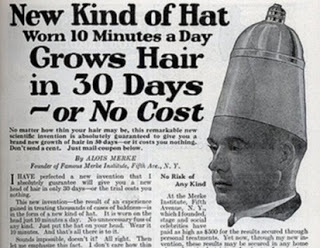
Gives a whole new meaning to the phrase 'hat hair'

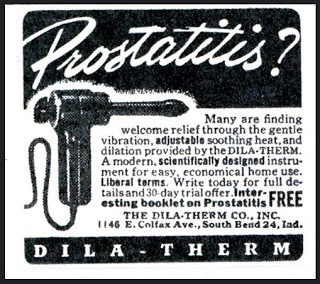
So let me get this straight: it's advertised for a male condition; and, you 'buy it for your husband'? Genius! Probably comes in a brown paper wrapper to boot.


I vote we bring back both the condition known as 'hysteria', as well as this cure for it. Are you with me?
I see quackery advertised every day online. It's a dead giveaway if they promise something in X number of easy steps, or magical results if you share with everyone you know. But none of them come close to being this artful, or this funny (even though they didn't intend to be). Thanks, quacks, for the best laugh of the day.
Fun page dividers from clipart.co
This post represents my participation in the 2016 A to Z Blog Challenge. We're working our way through the alphabet with posts relating to a different letter most days throughout April. Would love to hear from you in the comments section below. Thanks for dropping by!
Scams via infomercials and email are just the latest iteration of snake oil salesmen/women. They have a fine tradition in print media long before the Internet came along. Preying on an unsuspecting and uninformed public is their stock in trade. Take for example:

I don't know about you, but I'm totally not wearing anything on my face that has the word 'toilet' in its name.


And where was this little beauty when I was looking for a topic for P??


Know someone who drinks too much booze? Get them addicted to cocaine instead!


Gives a whole new meaning to the phrase 'hat hair'


So let me get this straight: it's advertised for a male condition; and, you 'buy it for your husband'? Genius! Probably comes in a brown paper wrapper to boot.


I vote we bring back both the condition known as 'hysteria', as well as this cure for it. Are you with me?
I see quackery advertised every day online. It's a dead giveaway if they promise something in X number of easy steps, or magical results if you share with everyone you know. But none of them come close to being this artful, or this funny (even though they didn't intend to be). Thanks, quacks, for the best laugh of the day.
Fun page dividers from clipart.co
This post represents my participation in the 2016 A to Z Blog Challenge. We're working our way through the alphabet with posts relating to a different letter most days throughout April. Would love to hear from you in the comments section below. Thanks for dropping by!
Published on April 21, 2016 06:30
April 20, 2016
Pan Car Didn't Pan Out
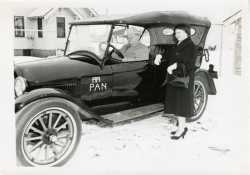 Mr. and Mrs. Pandolfo show off their babyThe birth of the automobile industry reminds me of other business booms. Somebody gets a great idea, or has some success, and suddenly everybody jumps on the bandwagon, hoping to cash in before another fad takes its place. History, and lots of barns you see on American Picker, is/are littered with the carcasses of the cars that didn't make it. The Pan Car falls into this category.
Mr. and Mrs. Pandolfo show off their babyThe birth of the automobile industry reminds me of other business booms. Somebody gets a great idea, or has some success, and suddenly everybody jumps on the bandwagon, hoping to cash in before another fad takes its place. History, and lots of barns you see on American Picker, is/are littered with the carcasses of the cars that didn't make it. The Pan Car falls into this category.The Pan Car concept was conceived by a fellow named Samuel Connor Pandolfo. As a traveling salesman, Pandolfo felt his ideas for making a travel-friendly vehicle would be a success. The Mississippi-born Pandolfo planned to locate his manufacturing plant in St. Cloud, Minnesota, northwest of the Twin Cities. St. Cloud had easy access to two things a car factory needed: plenty of iron ore to build them with (they don't call that area the Iron Range for nothing); and a way to ship them to market (via rail to the shipping hub at Duluth).
 Pandolfo did a 1917 version of Kickstarter and hit the road selling inexpensive shares of stock to fund his dream. He threw the mother of all barbecues to celebrate the prototype - and sell stock. He tried marketing by mail - to sell stock. He sold a lot of stock (around $10 million by some estimates), but car factories cost a bundle to build and run. Between car sales and stock sales, he just wasn't able to cover his expenses. Some considered his business plan something of a swindle. (I feel the pain. Ask me about my shares of Excelsior Henderson motorcycle stock.) Some say Pandolfo was a victim of auto and other big business conspiracies to block his success. He was convicted of mail fraud and did some time.
Pandolfo did a 1917 version of Kickstarter and hit the road selling inexpensive shares of stock to fund his dream. He threw the mother of all barbecues to celebrate the prototype - and sell stock. He tried marketing by mail - to sell stock. He sold a lot of stock (around $10 million by some estimates), but car factories cost a bundle to build and run. Between car sales and stock sales, he just wasn't able to cover his expenses. Some considered his business plan something of a swindle. (I feel the pain. Ask me about my shares of Excelsior Henderson motorcycle stock.) Some say Pandolfo was a victim of auto and other big business conspiracies to block his success. He was convicted of mail fraud and did some time. I'm likin' the two-toneFewer than 1000 Pan Cars were sold before the factory was forced to shut down. Today there are only about seven Pan Cars known to exist. A dedicated group of Pan Car enthusiasts scours the nearby countryside in search of overlooked Pan Cars, but usually must be satisfied with bits and pieces which they have painstakingly rebuilt over the years. The Pan Car price started at $1,000. Today, if you could find one, depending on the condition it could be worth a lot. How much, I don't know. I'm in the process of reaching out to some folks who can give me a number. In the meantime, I'll continue to ponder on this flash in the Pan.
I'm likin' the two-toneFewer than 1000 Pan Cars were sold before the factory was forced to shut down. Today there are only about seven Pan Cars known to exist. A dedicated group of Pan Car enthusiasts scours the nearby countryside in search of overlooked Pan Cars, but usually must be satisfied with bits and pieces which they have painstakingly rebuilt over the years. The Pan Car price started at $1,000. Today, if you could find one, depending on the condition it could be worth a lot. How much, I don't know. I'm in the process of reaching out to some folks who can give me a number. In the meantime, I'll continue to ponder on this flash in the Pan.This post represents my participation in the 2016 A to Z Blog Challenge. We're working our way through the alphabet with posts relating to a different letter most days throughout April. Would love to hear from you in the comments section below. Thanks for dropping by!
Published on April 20, 2016 15:00



